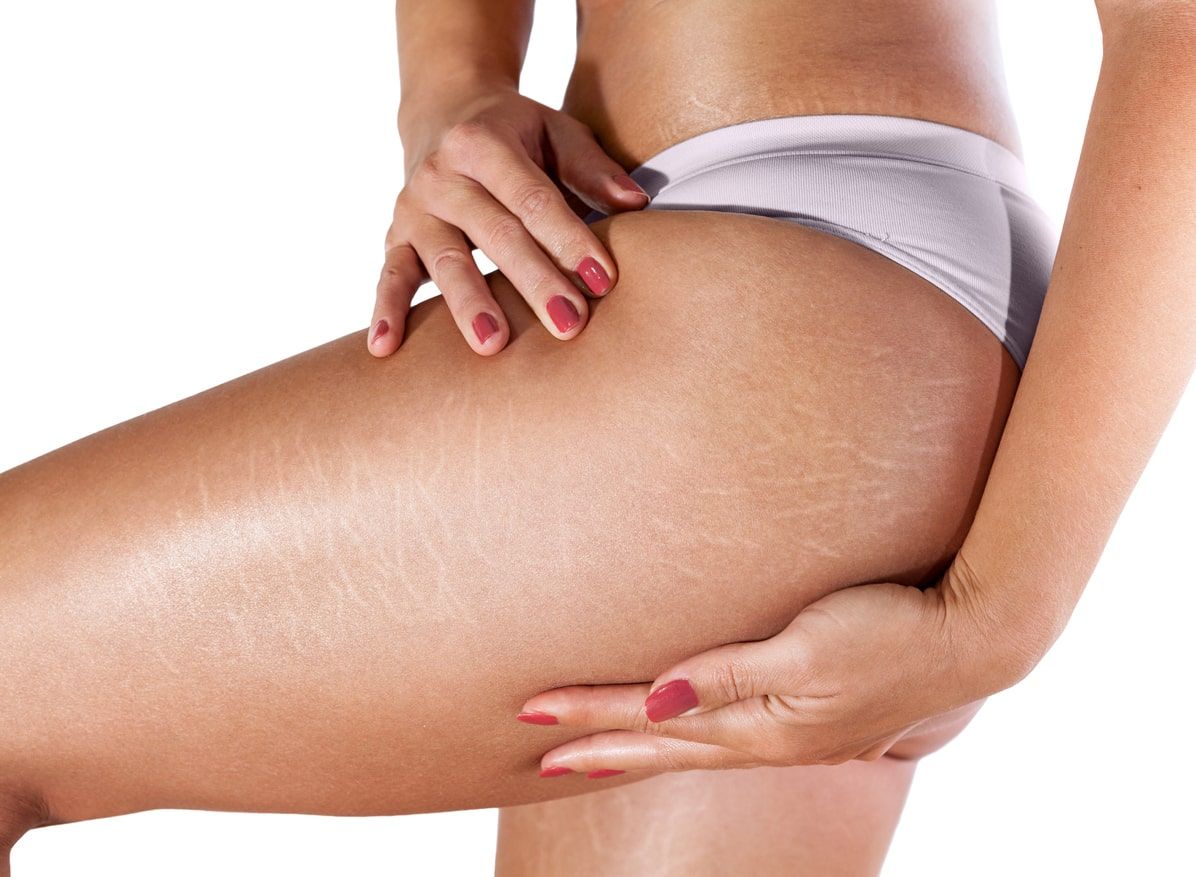Stretch Marks: What Are They and Do They Ever Really Go Away?


What are stretch marks? | How do stretch marks form? | What causes stretch marks? | Where can stretch marks appear on the body? | Do stretch marks go away? | Can stretch marks be prevented? | How can stretch marks be treated? | How to minimise existing stretch marks naturally? | In Conclusion
What are stretch marks?
The medical terms for stretch marks are striae, striae distensae (SD), striae atrophicans, and striae gravidarum. Stretch marks are a common skin condition that can affect both men and women.
Stretch marks can be red, purple, or white, and they often look like thin lines or streaks on the skin. stretch marks are typically harmless, but can sometimes be itchy or uncomfortable.
They are extremely common and do not cause any long-term health risks, however, in many cases, they can lead to low self-image and anxiety problems.
How do stretch marks form?
Stretch marks, or striae, develop when the skin is scarred from the inside out.
An increase in production of the glucocorticoid hormone inhibits the collagen fibroblasts required for taut, healthy skin.
If there is not enough collagen or elastin then when the skin stretches (in pregnancy for example) the layers of skin separate in the deeper layers.
This results in the angry red striations that eventually give way to, you guessed it, stretch marks.
Eventually, the traumatized skin loses pigment, taking on a more neutral colour.
What causes stretch marks?
Stretch marks are markings on the skin that can occur when the skin is stretched too far or too fast. This can happen due to circumstances such as:
- Weight Gain
- Weight Loss
- Adolescence (growth spurts)
- Pregnancy
- Use of some kinds of steroid tablets or creams
- Weight-lifting
- Genetic tendency
- Some medical conditions
Where can stretch marks appear on the body?
Stretch marks can appear anywhere on the body. But they are most likely to appear in areas where larger quantities of fat are stored. The most common areas are your:
- Abdomen (particularly near the navel)
- Busts
- Arms
- Underarms
- Back
- Upper legs
- Hips
- Buttocks
Do stretch marks go away?
The good news is that stretch marks will eventually fade, but the bad news is that they never really go away.
Over time, stretch marks will become less and less visible, but they are permanent.
There are a number of treatments available to help reduce their appearance, but none of them will completely eliminate stretch marks.
Can stretch marks be prevented?
Unfortunately, in the case of genetics, there is nothing you can do. If you're a woman, and your mother had stretch marks, then the chances of you getting them too are extremely high.
Therefore, it's all the more important to treat your stretch marks as soon as they first appear.
If you're a teenage girl then moisturiser should be your best friend! As it's during the teenage years and in young adulthood that stretch marks are most likely to form.
Of course, if you're reading this article, chances are you're past your teenage years, but that doesn’t mean you shouldn’t bother with moisturiser. No matter your age, your skin always needs to be kept hydrated.
The best places to apply moisturizer are on your hips, stomach, breasts, and buttocks.
How can stretch marks be treated?
Stretch marks can be treated with:
Topical creams
This is the most affordable and easily accessible way to treat stretch marks for most people.
I’m sure you already know that there are a lot of creams out there claiming to perform miracles on your stretch marks. You may even have tried a few and had lackluster results!
So how is Skinception Intensive Stretch Mark Therapy different from other products you may have tried? Well, for a start it fades stretch marks with a potent, yet gentle formula.
Consisting of natural ingredients and patented peptides, it's clinically proven to reduce stretch marks by up to 72.5% in just two months.
At the end of a recent study, even the researchers were amazed at the reduction in both the depth and length of stretch marks after participants used Skinception.
And there's more good news for people suffering from stretch marks. Another active ingredient in Stretch Mark Therapy, Pro-Coll-One+, stimulated collagen production by as much as 1190% when applied in a 2% concentration in a 56-day separate study.
Seventy-eight percent of study participants saw a noticeable improvement in skin smoothness, which improved by up to ten percent.
Skinception Intensive Stretch Mark Therapy is formulated with Regestril and ProCollOne, both of which are excellent for collagen production and can reduce the appearance of stretch marks.
Coffee Scrubs

Body Oil Moisturisers
Bio-Oil Skincare Body Oil, Moisturizer for Scars and Stretchmarks

Brown Sugar Body Scrub
Brooklyn Botany Brown Sugar Body Scrub That Fights Stretch Marks

Laser therapy
Laser therapy is a common treatment option to remove white stretch marks. Lasers are used to penetrate the skin, triggering regeneration.
This stimulates the tissues around your stretch marks to heal at a faster rate. Several treatments will be necessary to notice the results.
Microdermabrasion
Microdermabrasion is a painless procedure to reduce the appearance of stretch marks. This procedure works by stimulating the skin to tighten collagen and elastin fibers in the upper layer of skin, known as the epidermis.
For effective results, microdermabrasion needs to be repeated over a period of time, so you will need to be prepared to pay for several sessions, as having the odd session here and there won’t really have any noticeable effect.
If you are prepared to pay for the required number of sessions, then microdermabrasion can be effective, but it isn’t guaranteed to fully remove stretch marks. The severity of your stretch marks will influence your results.
Chemical peels
A chemical peel is a type of skin treatment where an acidic solution is applied in order to burn off the surface layers of skin. The process removes dead and damaged skin cells and encourages skin regeneration.
There are three types of chemical peel you can use; alpha-hydroxy acid, glycolic acid, and phenol peels, also known as carbolic acid.
Alpha-hydroxy acid is the mildest chemical peel and phenol is the most aggressive chemical peel, so it’s worth doing some thorough research before choosing which chemical peel is right for you.
Microneedling
Microneedling, also called skin needling, collagen induction therapy (CIT), and percutaneous collagen induction (PCI) targets the dermis, the middle layer of your skin where stretch marks form.
During this procedure, tiny needles are poked into your skin to trigger collagen production. Increased collagen and elastin promote skin regeneration that can improve your skin’s appearance and reduce stretch marks.
Again, you’ll need more than one treatment over a course of months to see results, but it can be an effective treatment for reducing stretch marks, specifically for patients with darker skin.
How to minimise existing stretch marks naturally?
If you have stretch marks and they're already set, then you may be wondering what to do next? Well fortunately there are still plenty of things you can do.
We’ve all heard that drinking plenty of water is good for our health, but it’s also good for beautiful skin by keeping it hydrated.
I know it can be difficult, but if you can try to limit your caffeine intake this will also help your skin. If you're an absolute caffeine-lover, as most of us are, be sure to drink more water than caffeinated drinks.
As well as staying hydrated, you must also eat well. Healthy skin likes foods rich in zinc, protein, vitamins A and C, so load up on carrots, nuts, citrus fruits, fish, and eggs.
It goes without saying to avoid processed foods and foods high in sugar. A treat once in a while won’t hurt, but having these foods every day or every week will not do you, or your skin, any favors.
Finally, stay active and move around to get your blood flowing, even if it’s just walking. All these things combined not only make you healthy and happy but go a long way to improving your skin.
If you want to go the extra mile then just add Skinception Intensive Stretch Mark Therapy to your routine and you’ll be looking great and feeling beautiful and confident in your own skin in no time.
In Conclusion
In most cases, stretch marks do not go away completely. However, they may fade over time and become less noticeable.
Unfortunately, there is no guaranteed way to prevent stretch marks. But there are a few things you can do to help reduce the appearance of stretch marks, including using moisturiser, applying stretch mark cream or oil, and avoiding excessive sun exposure.
If you are unhappy with the appearance of your stretch marks, you may want to consider seeking medical treatment. But be sure to research any procedure thoroughly to make sure you understand the risks involved before you go ahead with it.


